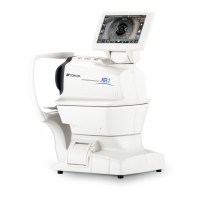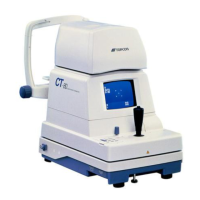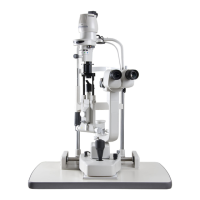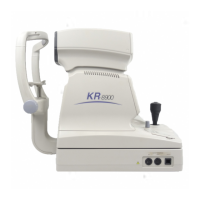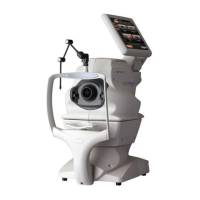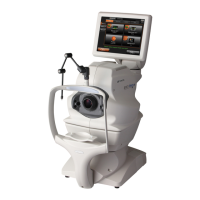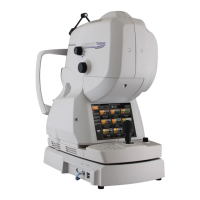INTRODUCTION Page: 3 FEATURES Highlights the KR-1's simplicity, adjustable touch panel, and auto start function for quick measurements.
PURPOSE OF THIS MANUAL Outlines the manual's content, covering basic operation, troubleshooting, maintenance, and safety precautions.
ENVIRONMENTAL CONDITIONS Details the required operating environment including temperature, humidity, and atmospheric pressure.
CAUTIONARY NOTES Provides essential notes on instrument usage, handling, power, and cleanliness for accurate results.
PREPARATIONS Page: 21 INSTALLATION Provides instructions for safely moving and placing the instrument on an instrument table.
DATA OUTPUT Describes how to connect to a PC or other devices for data output via RS232C or LAN.
DATA INPUT Explains how to input ID numbers from external devices via USB.
PRINTER PAPER SETTING Provides step-by-step instructions for loading printer paper, including safety precautions.
SETTING FUNCTIONS ON SETUP SCREEN Page: 46 UP;DOWN BUTTON Instructions on using up/down buttons to change settings on the screen.
TEN-KEY Guide on using the ten-key input method for entering numerical data.
KEYBOARD Instructions for using the on-screen keyboard to input character data.
INITIAL (INITIAL SETTING) Details the initial settings related to power-on status, measurement defaults, and system parameters.
LAN CONNECTION (LAN) Configuration options for establishing and managing LAN network connections for data output.
OPERATOR ID Settings for managing operator identification, including display and registration.
SPECIAL Mode reserved for service engineers, not accessible for standard user operations.
MAINTENANCE Page: 65 DAILY CHECKUPS Regular checks to ensure the instrument's accuracy and proper functioning.
CLEANING THE INSTRUMENT Instructions for cleaning various parts of the instrument, including the measuring window and light sources.
DAILY MAINTENANCE General daily maintenance tasks, including dust prevention and power switch operation.
USER MAINTENANCE ITEM Checklist for user maintenance, covering inspection, cleaning, and replacement tasks.
PRINTER PAPER JAM Steps to clear a paper jam from the printer, including safety precautions.
FUSE CHANGE Detailed instructions for safely replacing the instrument's fuse.
CLEANING THE COVER Instructions for cleaning the instrument's cover, emphasizing caution with solvents.
INTRODUCTION Page: 3 FEATURES Highlights the KR-1's simplicity, adjustable touch panel, and auto start function for quick measurements.
PURPOSE OF THIS MANUAL Outlines the manual's content, covering basic operation, troubleshooting, maintenance, and safety precautions.
ENVIRONMENTAL CONDITIONS Details the required operating environment including temperature, humidity, and atmospheric pressure.
CAUTIONARY NOTES Provides essential notes on instrument usage, handling, power, and cleanliness for accurate results.
PREPARATIONS Page: 21 INSTALLATION Provides instructions for safely moving and placing the instrument on an instrument table.
DATA OUTPUT Describes how to connect to a PC or other devices for data output via RS232C or LAN.
DATA INPUT Explains how to input ID numbers from external devices via USB.
PRINTER PAPER SETTING Provides step-by-step instructions for loading printer paper, including safety precautions.
SETTING FUNCTIONS ON SETUP SCREEN Page: 46 UP;DOWN BUTTON Instructions on using up/down buttons to change settings on the screen.
TEN-KEY Guide on using the ten-key input method for entering numerical data.
KEYBOARD Instructions for using the on-screen keyboard to input character data.
INITIAL (INITIAL SETTING) Details the initial settings related to power-on status, measurement defaults, and system parameters.
LAN CONNECTION (LAN) Configuration options for establishing and managing LAN network connections for data output.
OPERATOR ID Settings for managing operator identification, including display and registration.
SPECIAL Mode reserved for service engineers, not accessible for standard user operations.
MAINTENANCE Page: 65 DAILY CHECKUPS Regular checks to ensure the instrument's accuracy and proper functioning.
CLEANING THE INSTRUMENT Instructions for cleaning various parts of the instrument, including the measuring window and light sources.
DAILY MAINTENANCE General daily maintenance tasks, including dust prevention and power switch operation.
USER MAINTENANCE ITEM Checklist for user maintenance, covering inspection, cleaning, and replacement tasks.
PRINTER PAPER JAM Steps to clear a paper jam from the printer, including safety precautions.
FUSE CHANGE Detailed instructions for safely replacing the instrument's fuse.
CLEANING THE COVER Instructions for cleaning the instrument's cover, emphasizing caution with solvents.
